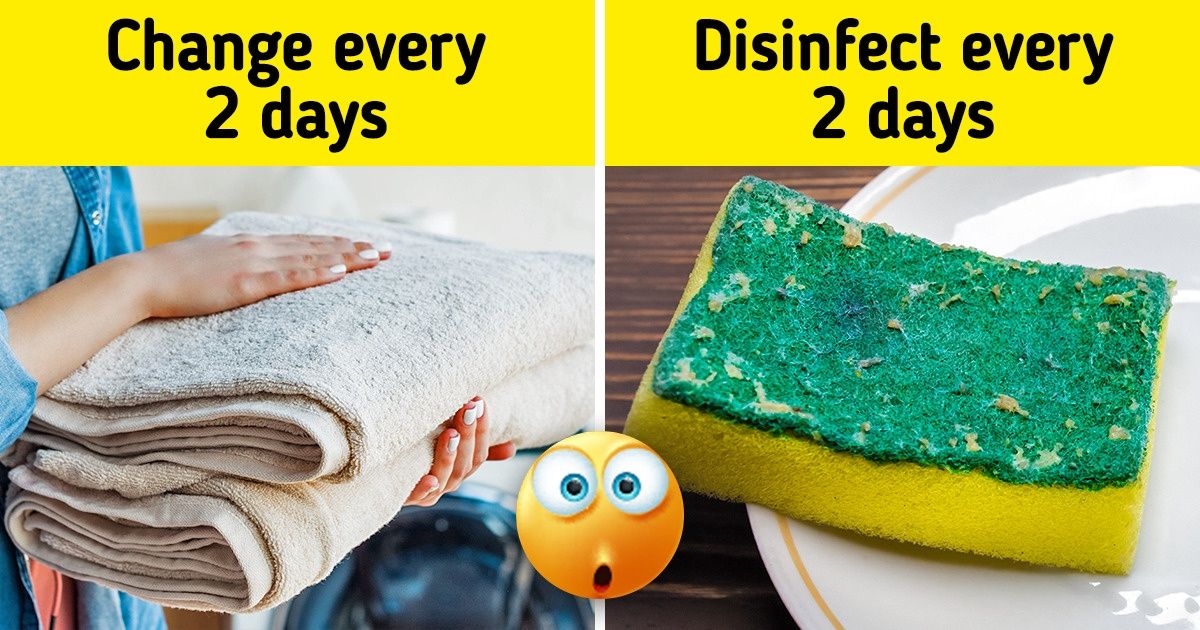15 Stories That Prove a Small Spark of Kindness Can Light Up a Fading Soul


There are people who love cleaning and at the slightest oversight they are ready to take out their sponge and soap to make everything spotless again, but there are others who are a little more relaxed about it and who don’t worry about the little details. The secret of cleanliness lies in the frequency with which we carry out the maintenance of our surroundings. In this way, we form habits that help us organize our time and allow everything to be always sparkling clean.
Bright Side prepared a small list of objects that we should be cleaning more frequently, otherwise, we could be putting our health at risk.
We are aware that cutting boards are a must in every single kitchen. However, if they’re not carefully cleaned they could put your family’s health at risk precisely because they’re used to prepare pretty much everything. It is recommended that you have different types of cutting boards so that you can use one per food group (one for fruits and veggies, one for meats, etc.). All of them should be cleaned with an antibacterial detergent and hot water after you use them to remove any food leftovers that could potentially contaminate fresh food for the next meal. It is also important to dry them very well to avoid humidity that favors the proliferation of microorganisms.
But in addition to this type of “superficial” cleaning, it is also important to perform a much more thorough disinfection routine to make sure that you indeed got rid of all the bacteria that remain on the surface. In order to do that, it’s recommended to wash them with lemon and salt. Both of these ingredients should be allowed to act for at least 5 minutes on the cutting board. Then you can remove them using paper towels. Remember to change the boards when you see they have imperfections or cracks that make cleaning difficult.
Wood is a very porous material that allows many substances to be absorbed, and this includes, of course, food residue and moisture. It’s because of these reasons that utensils made of wood should be cleaned immediately after using them before the wood absorbs the food leftovers. You should also make sure to dry them very well before storing them, as this will prevent the subsequent contamination of food and the proliferation of bacteria.
Your bathroom, and more specifically your toilet, is an excellent host for a little bacteria called Escherichia coli, known for causing infections. Unfortunately, E. coli can be found up to around 2 meters away (almost 7 feet) from the toilet and sink thanks to something called toilet plum. So, at the very least, it’s recommended that you get your hands on and perform a weekly deep cleaning to make sure your bathroom is E. coli free.
On the other hand, the bathtub should also be sanitized every 2 weeks or weekly if it is used very frequently.
Mold is the main enemy that you want to keep at bay from all of your rooms. Spotting some of it at home and in bathrooms is fairly common because of humidity, poor ventilation, and temperature changes. However, that doesn’t mean you can’t fight back. Cleaning the shower curtain after each use to remove soap residue and keep the area ventilated in order to eliminate moisture and steam condensation is essential to stop mold from proliferating in those sensitive areas.
In addition to your regular bathroom cleaning routine, it’s important to do a weekly deep cleaning of the curtains, washing them with a little bit of baking soda and soap. Make sure to not forget to check the manufacturer’s instructions so you know how to wash it properly. Typically, this should be done in a delicate wash cycle at a low temperature. Once that’s done, wait for them to dry without exposing them directly to the sun.
All towels, especially the ones you use after showering, harbor a lot of bacteria, sweat, and dead skin because of how we use them. If on top of that, we don’t make sure they dry completely after each use, they can become the perfect ecosystem for germs to thrive in. Therefore, it is vividly recommended that we change towels every 2 days and wash them immediately, preferably at a high temperature, using a detergent containing active oxygen to penetrate the fabric and eliminate bacteria. It is also advisable to avoid mixing them with regular clothes.
Sheets absorb perspiration and oils released by the skin during sleep. Not only that, but they also capture some of the dust that’s floating around the room. This is the perfect cocktail for dandruff and acne to appear. Changing or washing your sheets once a week is the most effective way to keep the bed clean and free of microorganisms that could affect your skin and hair.
Typically, areas, where food is stored or prepared, have more bacteria and fecal contamination than other places in your home. While this might seem strange at first, you might want to consider that scientists found that more than 75% of sponges and dishcloths could potentially contain traces of infectious agents like Salmonella, or E. coli. And that’s not all. Some of them may even have fecal matter on them. Compare that number to the 9% found on bathroom faucet handles to put things into perspective...
The good news is that you don’t need any type of special treatment to fix this problem. Just soaking the sponges in boiling water for about 2 minutes or placing them in the microwave for 2 minutes every other day while they are still wet is sufficient. This is enough to get rid of the bacteria that you can find on their surface. When sponges start to break, it’s important to change them so that they won’t be able to harbor more bacteria. Regarding kitchen towels, it is recommended to wash them weekly, unless you’ve handled raw meat and then touched them. In that case, they should be washed immediately.
According to Natalie Barret, cleaning supervisor and expert at Nifty Cleaning Services, pillows should be washed every 3 to 6 months. Depending on each person’s type and quantity of sweat, it is recommended to wash them at least twice a year, but in special cases, more frequent cleaning may be needed, like for example, if you sweat a lot during the night or if you live in a very humid house or country.
Alex Savy, a certified sleep science trainer and founder of SleepingOcean, explains that pillows carry sweat, dead skin, dust, and germs. It’s because of that and other factors that they attract dust mites, making it the best place for them to reproduce. These, in turn, could potentially cause allergies, watery or itchy eyes, rashes, and even an increased risk of asthma.
The refrigerator houses all types of food that share what can be understood as a sort of small ecosystem. Because of that, it’s extremely important to organize food according to its type in order to avoid cross-contamination when storing things in the fridge and, second of all, to keep the whole thing clean. It is estimated that a thorough cleaning 4 times a year and maintenance once a week is enough to keep the space sanitized.
Philip Tierno Jr. Ph.D., a clinical professor of microbiology and pathology at New York University School of Medicine, says that “stoves tend to be somewhat neglected. Splatters or spills of food that aren’t promptly cleaned up can become a good medium for the growth of microbes,” which is a great argument in favor of cleaning your kitchen thoroughly.
On the other hand, Melissa Maker, a cleaning expert, believes that stoves should be cleaned after each use. She’s not talking about deep cleaning, but simply about using your regular universal cleaner and a microfiber cloth. As for the oven, both inside and outside, it should be cleaned every 3 months, or when you notice that the food inside has burned or that smoke comes out when you use it.
In a study, it has been shown that conventional washing machines are not exempt from harboring plenty of different types of germs, especially if bleach is not used regularly with the wash, which might be a common case given that it’s a powerful compound that can deteriorate certain fabrics. So it is recommended to perform an empty cycle only with water and a cup of bleach weekly or even twice a week. If the washing machine has a special germicidal cycle, the manufacturer’s instructions should be followed.
The accumulation of food and soap leftovers can create layers of dirt if you allow them to accumulate there. These layers can become a breeding ground for both bacteria and fungi due to their constant contact with the food and debris on their surface. To avoid this from happening, it is ideal to clean the sink weekly with a mild bleach solution.
This is often an accessory that can be forgotten when cleaning your fridge. However, that might be a big mistake as it harbors the greatest amount of moisture and dirt from that particular appliance. This area allows the hermetic seal to maintain the cold inside the fridge by preventing it from escaping. But not performing a regular cleaning could affect the storage of food and cause its deterioration before it is time. So it’s recommended that you clean your refrigerator rubber twice a year with a sponge and a combination of water and dish soap.
Another utensil that’s often pointed to as a suspect of enabling food cross-contamination in the kitchen is the blender. It is easy to leave processed food residues in there because it’s full of irregular shapes that hard to reach. Because of that, it should be cleaned with an antibacterial detergent and plenty of water after every time it is used. Additionally, after the third or fourth use, it is recommended to perform a deep cleaning to get rid of certain odors. You can do that by mixing vinegar, water, and dish soap. Just add all the ingredients, turn the blender on, and let them mix for 5 minutes. After that, just rinse it and let it dry completely.
According to the American Academy of Dermatology, most people lose between 50 and 100 strands of hair every day. Of course, you don’t walk around your house and run into loose hair all the time. That’s because most of them end up tangled in your hairbrush. That, in turn, makes cleaning this particular object very important. After all, hair can easily turn into a breeding ground for dirt, bacteria, and fungus.
There is no fixed rule when it comes to cleaning a hairbrush, but you can be sure the frequency with which you do it will vary depending on how much you use it and the type of products you apply to your hair. If you use hair creams, hair gel, or hairspray, weekly cleaning is sufficient. If, on the other hand, you don’t use any chemicals, you could do it every 2 or 3 weeks. In addition, it is recommended to remove hair that has gotten tangled between the bristles every 2 days or so.
These infallible accessories accompany you almost everywhere you go. But take into account that they usually rest on various surfaces, and it is even normal for other people to use them and touch them. So, given that you won’t be washing your hands every single time before touching them, they turn your hands into germ hosts, and without timely cleaning, all of these substances are transmitted to all the places they touch, including your face and mouth.
That is why these items should be disinfected at least once a day or after each use.
For coffee lovers, coffee makers have become an indispensable appliance in their homes, but the cleaning of filters and pots is an important habit to develop if you want to keep everyone at home as healthy as possible. Therefore, it is recommended to clean the coffee maker after each use, removing the filters and cleaning the brewing basket. A decalcification cleaning should also be done every 3 months to remove mineral deposits in the ducts.
Pets are always a happy addition to have at home. They’re loyal and cute companions that will always be there to support you when needed. But it is also important to take into account that they can host and transmit multiple diseases to humans, so it is of the utmost importance to establish cleaning routines for the objects they use, like bowls, which should be washed after every meal, water tanks, these can be washed every 2 days, and toys. The frequency with which you wash these will depend on the specifications given by the manufacturer.
This element of decoration is very popular all over the world because it gives a feeling of warmth and comfort in some of the most important areas of your home. However, depending on how many people share this space and how often you actually use the carpets and rugs, you should consider washing them more or less frequently. In any case, take into account that they have a high level of absorption of dust, mites, and germs — most of which are found on the soles of your shoes. That’s why it is recommended to vacuum them frequently. It is advisable to do it every week, and if you have pets, more often, to keep dust, dirt, and allergens at bay.
Research done by Aston University found that 9 out of 10 makeup bags have potentially deadly superbugs. In fact, this study managed to prove that they found bacteria that can cause illnesses like skin infections if the products are used near the eyes or mouth, so it’s extremely important to keep your makeup bag tidy at all times and clean it regularly to avoid any of these infections.
The study says that “more needs to be done to help educate consumers and the makeup industry in general about the need to wash sponges regularly and dry them completely, as well as the risks of using makeup beyond its expiration date.” For example, the American Academy of Dermatology recommends washing makeup brushes every 7 to 10 days to protect the skin and avoid exposing the face to bacteria and fungi.
And you, how often do you clean these places and objects? What are your best cleaning tips?











